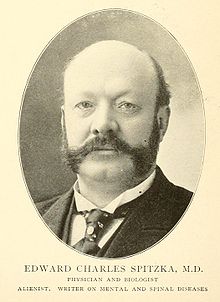Edward Charles Spitzka

Edward Charles Spitzka (November 10, 1852 - January 13, 1914) was an eminent late-19th century alienist, neurologist, and anatomist. Dr. Spitzka was the author of the landmark psychiatric manual "Treatise on Insanity,. Its Classification, Diagnosis and Treatment," published in 1883. He pioneered studies of the anatomy of the human nervous system, and discovered the interoptic lobes of saurians in the human brain.
He was the father of the noted alienist, Edward Anthony Spitzka.
Educaton
Spitzka was born in New York City, the son of Charles A. Spitzka and Johanna née Tag. He attended Public School No. 35, the College of the City of New York, and the Medical Department of the University of the City of New York, where he graduated in 1873. He spent the next three years in Europe, where he studied at the medical schools of the University of Leipzig and the University of Vienna. From 1874 to 1875 he served as an assistant to the chair of embryology at the University of Vienna.
Career
In 1876 Spitzka returned to New York City, specializing in the diagnosis and treatment of internal diseases, particularly of the human nervous system. He practiced surgery at Mount Sinai Hospital and was a consulting neurologist to the North-Eastern Dispensary and St. Mark's Hospital. He was a professor of nervous and mental diseases and of medical jurisprudence at the New York Post-Graduate Medical College from 1882 to 1887. In 1890, Spitzka served as President of the American Neurological Society. In 1883/1884, he served as President of the New York Neurological Society.
President James A. Garfield Assassination and Trial of Guiteau
In 1881, Spitzka was an expert witness at the trial of Charles J. Guiteau, who was accused of the assassination of United States President James A. Garfield. The trial was one of the first high-profile cases in the United States where the insanity defense was considered. While on the stand, Spitzka testified that he had "no doubt" that Guiteau was both insane and "a moral monstrosity." Spitzka came to the conclusion that Guiteau had "the insane manner" he had so often observed in asylums, adding that Guiteau was a "morbid egotist" who "misinterpreted and overly personalized the real events of life."[1]
Guiteau was found guilty of assassinating Garfield, despite his lawyers raising an insanity defense. He was sentenced to death, and executed by hanging on June 30, 1882, in Washington, D.C.
Bibliography
- Haines, D E. "Spitzka and Spitzka on the brains of the assassins of presidents". Journal of the history of the neurosciences 4 (3-4): 236–66. ISSN 0964-704X. doi:10.1080/09647049509525641 PMID 11619027
